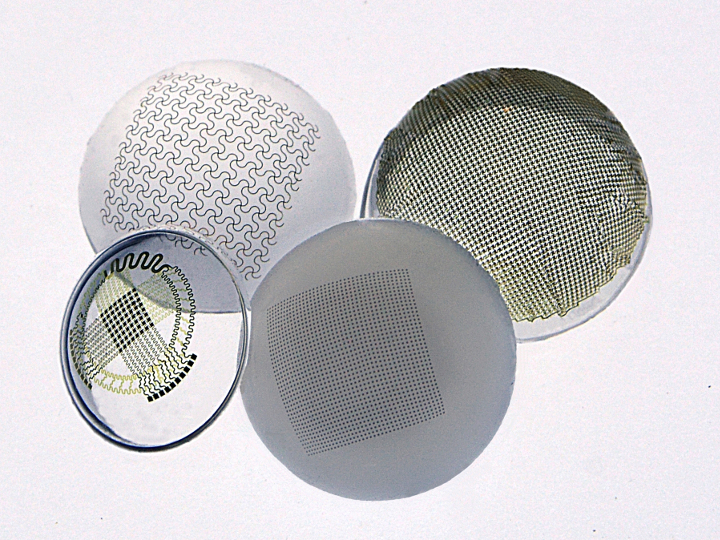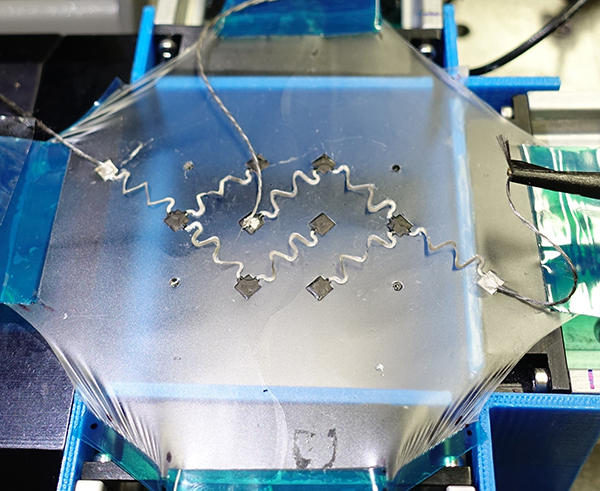(This flat structure morphs into shape of a human face when temperature changes)
2019/9/30 アメリカ合衆国マサチューセッツ工科大学(MIT)
・ MIT の研究チームらは、周囲の温度変化に反応して、フラットな層から所定の形状に変形する 3D プリントによるメッシュ状の構造体を設計。これまでに開発された他の可変形状の材料よりも、複雑な形状に変形。
・ 研究者らは試作品として、特定の温度差で人間の顔の形に変形するフラットなメッシュ状の構造体を作製。また、導電性の液体金属を内蔵したメッシュも設計し、ドーム状に湾曲してアクティブアンテナを形成し、変形に応じて共振周波数が変化。
・ 研究チームの新しい設計手法は、プリントする材料の特性を備えたフラットなメッシュ状の構造体の特定のパターンを、構造体が目標の形状に変形するよう決定させるために使用可能。
・ 形状を複雑に変化させることができる構造体は、人工組織のステントや骨格に、または望遠鏡の変形可能なレンズなどにも使用できる。
・ 研究チームではさらに、くらげロボットなど、水中で形状を変えて泳ぐようなものに組み込む計画。人工的な筋肉のような作動装置として使用し、温度差に応じて次々と変形できれば、ソフトロボティクスの新しい設計が可能。
・ 本研究は、2 年前に、薄いフラットなシートを人間の顔のような複雑な形状に変形する、理論的な設計を考案したことがきっかけとなった。二重層の材料シート領域が、目標の形状に変形する際の膨張と収縮に関する計算式を考案し、理論的な材料でシミュレーションするコードを開発。その後実験し、フラットな連続シートが、複雑な人間の顔に変形することを視覚化。
・ しかし、研究チームは、その技法が大部分の物質的な材料に適用しないことを発見。シミュレーションに使用した連続シートは理論上の材料であり、膨張や収縮の量に関する物理的な制約は含まれていない。実在するほとんどの物質は、表面が同時に2つの垂直な方向に曲がる、二重曲率と呼ばれる効果により、成長能力が非常に限られている。
・ そこで研究者らは、可変形状シートに二重曲率を付与するために、構造体の基盤を表面が連続したシートからメッシュシートに切り替えた。
・ これにより、温度誘起された格子骨の折り曲げは、メッシュノードの膨張と収縮を拡大させ、また、格子の隙間を格子骨が異なる比率でシート上に成長するように設計すると、表面上の大きな変化が容易になることが期待された。
・ 研究者らはさらに、各格子骨が所定の角度に曲がるように設計。各格子骨には、4つのより細い格子骨を設計し、2 つの格子骨を並べてそれぞれ重なり合うようにした。4つの細い格子骨は全て、注意深く選別した同一素材のバリエーションで、温度差で所定の異なる反応を示す。
・ 4つの細い格子骨が集まってひとつの大きな格子骨を形成するようにプリント過程で結合させると、格子骨全体が、より細い格子骨間の温度応答の差で曲線を形成。温度反応が高い格子骨はより長く伸びるが、応答性の低い格子骨と結合しているので、伸長には抵抗が働き、格子骨全体は伸びずに湾曲する。
・ 研究チームは、このような 4 つの格子骨を使用して人間の顔の形に湾曲する格子を作製するために、まずその幾何学理論が同研究アプローチに近い数学者、ガウスの顔の 3D 画像を作製。この画像から、フラットな表面に顔の形の凹凸をつけるために必要な格子間の距離マップを作製。その後、各距離間を、特定のパターンの格子骨や、各格子骨内のより細い格子骨の比率を含んだ格子に転換するアルゴリズムを考案。
・ 研究チームは、温度の上昇で自然に膨張するゴム材料の PDMS で格子をプリント。ガラス繊維の溶液を注入して材料の温度反応を調整し、物理的に硬化させ、温度変化に対する耐久性をもたせた。
・ 材料に格子状のパターンをプリントした後、炉で 250℃に加熱し、取り出して塩水に漬け、室温まで冷却すると、人間の顔の形に変形。
・ 研究チームはまた、液体金属インクが埋め込まれたリブで作製した格子状の円盤を印刷。様々な種類のアンテナで、格子がドーム状に変形する度に共振周波数が変化する。
・ 現在本技術を、温度応答性のテントや自力で進むフィンや翼など、より頑丈なアプリケーション用の硬い材料で設計する手法を開発中。
・ 本研究は、米国科学財団(NSF)および Draper Laboratory より一部支援を受けた。
URL: http://news.mit.edu/2019/mesh-structure-shape-temperature-changes-0930
(関連情報)
米国アカデミー紀要(PNAS)掲載論文(アブストラクトのみ:全文は有料)
Shape-shifting structured lattices via multimaterial 4D printing
URL: https://www.pnas.org/doi/full/10.1073/pnas.1908806116
<NEDO海外技術情報より>
Researchers at MIT and elsewhere have designed 3-D printed mesh-like structures that morph from flat layers into predetermined shapes, in response to changes in ambient temperature. The new structures can transform into configurations that are more complex than what other shape-shifting materials and structures can achieve.
As a demonstration, the researchers printed a flat mesh that, when exposed to a certain temperature difference, deforms into the shape of a human face. They also designed a mesh embedded with conductive liquid metal, that curves into a dome to form an active antenna, the resonance frequency of which changes as it deforms.
The team’s new design method can be used to determine the specific pattern of flat mesh structures to print, given the material’s properties, in order to make the structure transform into a desired shape.
The researchers say that down the road, their technique may be used to design deployable structures, such as tents or coverings that automatically unfurl and inflate in response to changes in temperature or other ambient conditions.
Such complex, shape-shifting structures could also be of use as stents or scaffolds for artificial tissue, or as deformable lenses in telescopes. Wim van Rees, assistant professor of mechanical engineering at MIT, also sees applications in soft robotics.
“I’d like to see this incorporated in, for example, a robotic jellyfish that changes shape to swim as we put it in water,” says van Rees. “If you could use this as an actuator, like an artificial muscle, the actuator could be any arbitrary shape that transforms into another arbitrary shape. Then you’re entering an entirely new design space in soft robotics.”
Van Rees and his colleagues are publishing their results this week in the Proceedings of the National Academy of Sciences. His co-authors are J. William Boley of Boston University; Ryan Truby, Arda Kotikian, Jennifer Lewis, and L. Mahadevan of Harvard University; Charles Lissandrello of Draper Laboratory; and Mark Horenstein of Boston University.




